

Kendall Model Company M3 75mm GMC
by John Prigent
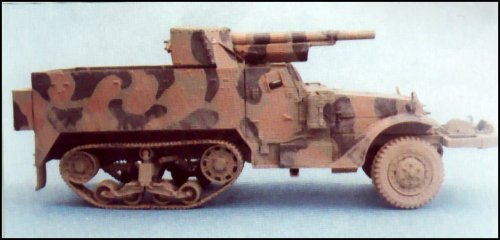
A HALFTRACK WITH A PUNCH
The M3 75mm Gun Motor Carriage was very much a full-size conversion, mounting the
US-built version of the old French "soixante-quinze" on an M3 halftrack to
produce a self-propelled anti-tank gun. 2,202 were built, making it the most
numerous halftrack variant after the M3 personnel carrier itself, and it saw service with
the US Army in the Philippines fighting of
1942 and in Tunisia, with the support companies of British Armoured Car Regiments in Italy
and North-West Europe, and with the US Marines in the island-hopping Pacific
campaign. This gives a fair variety of finishes to choose from!
The new Kendall Model Company conversion kit comes in resin and etched brass, and to
build it 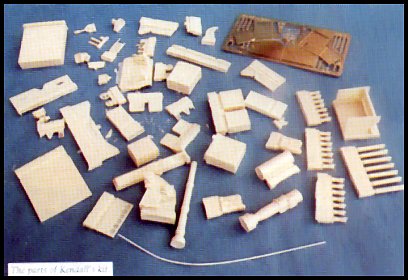 you'll also
need the Tamiya kit of the M21 mortar carrier - sometimes hard to find, but worth seeking
out for this conversion because Tamiya's other US halftrack kits have different rear
bodies. Their M16 kit has lowered flaps on the body sides and rear, provided on the
real thing to allow for traverse of its gun mount, and their M3A2 has so much moulded
detail to remove that in both cases it's easier to make new sides and rear from plastic
card - so look for the M21 instead and save some work.
you'll also
need the Tamiya kit of the M21 mortar carrier - sometimes hard to find, but worth seeking
out for this conversion because Tamiya's other US halftrack kits have different rear
bodies. Their M16 kit has lowered flaps on the body sides and rear, provided on the
real thing to allow for traverse of its gun mount, and their M3A2 has so much moulded
detail to remove that in both cases it's easier to make new sides and rear from plastic
card - so look for the M21 instead and save some work.
STARTING WORK
The chassis can be built as set out in Tamiya's instructions, but leave off the winch
and its drive shaft unless, like me, you fancy building one of the few M3 GMCs to carry a
winch. If you do, leave the drive shaft off until the cab is fitted - it has to go
through a hole in the radiator which is tricky to fit over it, but it pops into place
easily at a later stage. Kendall provides a resin
front roller and its mounts, which I dry-fitted for one of my photos to show you how good
it looks. If you use this the 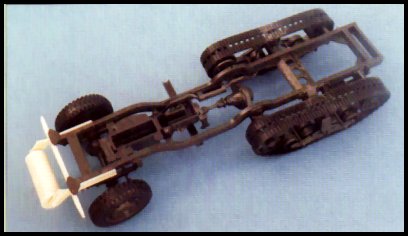 horizontal plates on the front of the chassis must be removed, as they
weren't used with the roller.
horizontal plates on the front of the chassis must be removed, as they
weren't used with the roller.
The cab is built straight from the Tamiya box, except that its armoured windscreen is
replaced with Kendall's resin part. This reproduces the type fitted to the M3 GMC,
hinged at the bottom instead of the top. Kendall provides neat etched brass hinges
to fit against it it you pose it up. Unfortunately it isn't a perfect fit that way,
being a straightforward oblong although its sides should slant to fit the cab front, but
this isn't really noticeable so I didn't modify it. .If you want the windscreen
dropped ready for action, you'll need to modify Tamiya's screen side pillars which have a
triangular section to fit their glazed screen surround (which isn't used for the M3
GMC). Cement plastic strip to them, let the cement dry and then file the pillars to
a square section.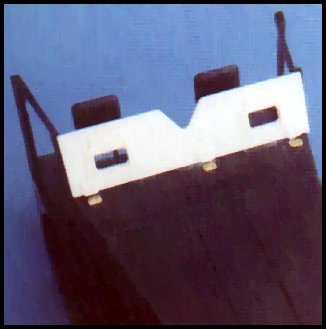 The cab
needs no changes on the inside, and the instrument panel paints up nicely. Note that the
American dial faces were white with black needles and markings, not like modern car
instruments with black faces and white markings. The seats should be khaki or
perhaps light olive drab cloth, the gear levers had black knobs, and the rest is olive
drab. You'll find it easiest to leave off the steering wheel (probably also black)
until the rest of the cab interior is painted.
The cab
needs no changes on the inside, and the instrument panel paints up nicely. Note that the
American dial faces were white with black needles and markings, not like modern car
instruments with black faces and white markings. The seats should be khaki or
perhaps light olive drab cloth, the gear levers had black knobs, and the rest is olive
drab. You'll find it easiest to leave off the steering wheel (probably also black)
until the rest of the cab interior is painted.
ALTERING YOUR BODY
No, not a session in the gym! Here's where you need some care, because Tamiya's
body floor has to be cut so the Kendall parts can fit. First, do the easy bit by
cutting the back wall as shown in Kendall's instructions - and do note that the back wall
is the one without a notch in its top - I nearly cut the wrong end which would have been a
disaster! Saw down each side of the area to be removed, then scribe across between
the saw cuts with a sharp blade guided against a steel ruler. Finally, snap the
surplus section away and file the remaining edge flat.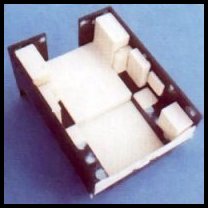
Now you'll have to cut away a section of the actual floor. This is not so easy,
but tackling a bit at a time makes it fairly straightforward. Use your saw at an
angle and cut from under the floor to remove as much as you can - I can't give precise
directions where to cut, just study the part and saw slowly! Take care to leave the
front uncut, and as much as you can of the centre floor which you'll need to support the
resin floor. When you've sawn all you can reach, scribe the rest with your knife
blade before snapping the surplus away and smoothing the edge.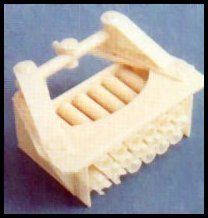
Fill the ejector pin marks in the plastic, then fit Kendall's floor sections.
Finally, cement plastic card into that notch in the front wall to fill it. Now you
can set to wrok on the sides and rear. Remove the "hinges" on them as
shown in Kendall's instructions and use strips of plastic card to fill the locations for
the mine racks which few M3 GMCs carried - unless you're modelling one from a photographs
which shows them fitted, of course. Fill the ejector pin marks inside these pieces
and add them to the floor, then fix Kendall's resin front wall in place.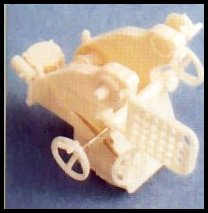
Remove the unused locating ribs inside the body, then add the new fuel tanks and other
fittings - the two filler caps on each tank are different sizes, the larger ones going to
the inside. You'll need to trim the outside bottom edges of the tanks and jerricans to fit
over the floor's locating ribs - just file a chamfer along them, it won't show when
everything's in place. Now
cement the cab to the body and paint all the undersides and chassis. I used Humbrol
29 dark earth overall to model a dirty vehicle, but use olive drab if you prefer a clean
one. Paint inside the body now, in olive drab, as you won't be able to reach all the
nooks and crannies once the gun's in place.
NOW FOR THE GUN
The main section of the gun mount: has a casting block which needs careful sawing to
remove, 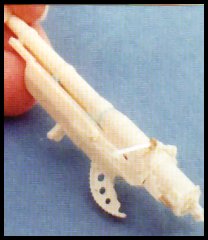 but the front
plate just needs to be scored along the joint and snapped off its block. The top
section is on a flat casting block, which needs to be removed till all that's left is a U
shape all on one level. Use wet'n'dry paper with plenty of water and sand with a
figure-of-eight motion to keep the bottom flat - check often to make sure you're not
taking more off one side than the other, and turn the part round to finish sanding if you
are. Don't clean out the holes in the front plate, they're not really holes filled
with flash but locations for the ends of the ammo stowage tubes. Take
care removing those ammo tubes from their
but the front
plate just needs to be scored along the joint and snapped off its block. The top
section is on a flat casting block, which needs to be removed till all that's left is a U
shape all on one level. Use wet'n'dry paper with plenty of water and sand with a
figure-of-eight motion to keep the bottom flat - check often to make sure you're not
taking more off one side than the other, and turn the part round to finish sanding if you
are. Don't clean out the holes in the front plate, they're not really holes filled
with flash but locations for the ends of the ammo stowage tubes. Take
care removing those ammo tubes from their 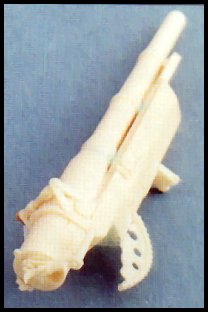 casting blocks, it's easy to crush their fragile open ends as I
found out. Fortunately Kendall gives plenty of spares!
casting blocks, it's easy to crush their fragile open ends as I
found out. Fortunately Kendall gives plenty of spares!
You'll have noticed that there's no marked location in the mount for the front
plate. This isn't a problem: superglue the short tubes to the rear of the mount, add
the long ones with their ends lined up with the short ones, then position the front plate
with the ends of the long tubes in the "holes" and Bob's your uncle. Add
the top plate and the cross-pice which the actual gun fits onto, and paint the
assembly. Note how the tubes fit, with the tabs on thelong ones and the short ones
of the middle row pointing down and those of the bottom row pointing up - mine are wrong
as I misread the instructions, so don't copy my photograph. The ammo tubes are
empty, but if you want a fully stowed GMC it should be simple to add shell ends
to the tubes.
Now for the gun cradle. Again, there's an awkward casting block to remove; saw it
away in sections and pare off the remaining stub with your knife - there's no need for
precision as the bottom of the carriage will be hidden inside the gun mount. 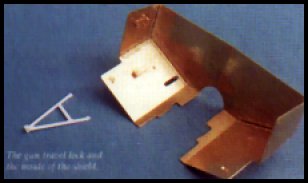 You may need to recut the slot in
the back where the elevation arc goes through the cradle; test fit to see when you've
built the
You may need to recut the slot in
the back where the elevation arc goes through the cradle; test fit to see when you've
built the
gun slide. The traverse gearbox goes on top, hanging over the front, and the
traverse arc simply glues underneath it. Kendall doesn't provide anything to hold it
to the gun mount, but I've no information on what should be there and it isn't really
visible when the model is completed. Dry-fit a straight length of wire through the
slot on the port side and check that it will go into the locating hole of the traverse
gear - if not, lengthen the slot until it does.
The gun tube is in two parts, so take care to line them up. Mine didn't fit
properly on the recoil slide, so I added slips of plastic card under the barrel bands to
lift the barrel and keep it in line, then a touch of filler to blend them in. Kendal
gives the breech in its open position, with an alternative part if you want it closed -
just file the back of the block flat and fit the new part on it . Either way, three small
parts build the operating mechanism as in my photo. 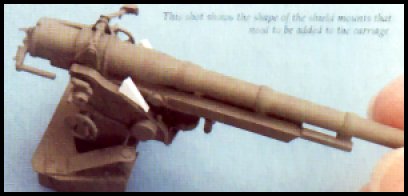 Add the triangular parts 41 to the top of the
barrel, making sure that they don't prevent its trunnions fitting into the cradle, then
add part 37 between them with the holes in
Add the triangular parts 41 to the top of the
barrel, making sure that they don't prevent its trunnions fitting into the cradle, then
add part 37 between them with the holes in
its square blocks pointing to the rear. Fix the travel lock part 32 under the
slide, just in front of the raised section, and the block part 38 to the side of the
breech. Find a bit of wire to make the connection from this block to the barrel, and
some brass rod for the handwheel shafts - the plastic rod which Kendall too thick and
you'll need it for the gun crutch anyway
Fix the shafts and handwheels, with etched part 12 under the shaft for the large
handwheel Although not shown in Kendalls's instructions, this is a brace for the
shaft. Kendall provides the standard indirect gunsight in resin, but I didn't fit it
as apparently only modified M3 GMCs carried it. 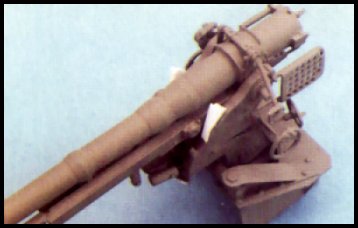 The plastic rod provided does nicely for the sight mount on the
port side. Add etched part 13 to the port side of the triangle structure on top of the
barrel, then a 9mm length of rod pointing down at 45 degrees with the un-numbered
resin part on its end. This is the direct sight mount - see my photos for the way it
should look when built. Unfortunately I couldn't find a photographs showing the
indirect telescope sight so didn't try to model it; add a plain length of plastic rod if
you want to represent it.
The plastic rod provided does nicely for the sight mount on the
port side. Add etched part 13 to the port side of the triangle structure on top of the
barrel, then a 9mm length of rod pointing down at 45 degrees with the un-numbered
resin part on its end. This is the direct sight mount - see my photos for the way it
should look when built. Unfortunately I couldn't find a photographs showing the
indirect telescope sight so didn't try to model it; add a plain length of plastic rod if
you want to represent it.
Kendall's plastic rod is also fine for the gun crutch which fit on the wall in front of the gun mount - Kendall shows its shape but for some reason doesn't give dimensions. I used two legs 17mm long, cemented together at the top and 10mm apart at base to fit the mounts on the body wall, then cut a crosspiece to fit a quarter of the way up from the base. The resin C-shape goes at the top, then it can be painted and fixed to its mounts.
THE GUN SHIELD
This is Kendall's master stroke. It comes in three main etched brass parts to be
bent and fixed together. The sides have recesses onto which the roof fits, and all
you have to do is adjust the roof's centre bend until the sides of the central gun opening
are parallel. Very simple, and surprisingly strong. 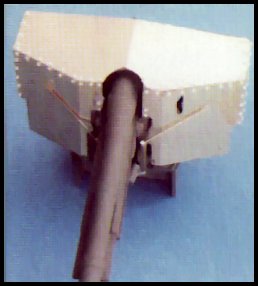 It's even stronger when you've fixed the internal
angle pieces in place - check, though, that you fix etched parts 4 and 8 on the correct
sides as their bottoms are angled to fit the slope of the shield. Kendall doesn't
provide bolt heads on the outside of the shield - as they rightly say, etching has its
limits! Add these, in the locations etched on the brass, from slices of plastic rod
or whatever method you prefer. Photographs show that there should also be bolt heads along
the edge of the roof, paired with the ones on the sides. Kendal doesn't mention
these, but I hope you can see from my photo how they fit. As an aside, Kendall
refers to bolt heads on the shield so I use that term here, but photos seem to show rivets
so don't worry too much about the facets which would show on bolt heads.
It's even stronger when you've fixed the internal
angle pieces in place - check, though, that you fix etched parts 4 and 8 on the correct
sides as their bottoms are angled to fit the slope of the shield. Kendall doesn't
provide bolt heads on the outside of the shield - as they rightly say, etching has its
limits! Add these, in the locations etched on the brass, from slices of plastic rod
or whatever method you prefer. Photographs show that there should also be bolt heads along
the edge of the roof, paired with the ones on the sides. Kendal doesn't mention
these, but I hope you can see from my photo how they fit. As an aside, Kendall
refers to bolt heads on the shield so I use that term here, but photos seem to show rivets
so don't worry too much about the facets which would show on bolt heads.
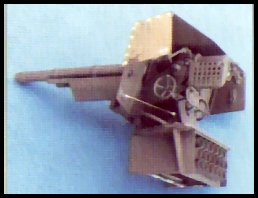 Once the shield's in
place the gun is finished, but the problem is that Kendall hasn't given any way of fixing
the shield to the gun! What's missing is a shield mount on each side of the
carriage. Make these from 1/2mm plastic card by cutting two rectangles 8mm by
3mm. Mark 3mm down one long edge of each, and cut from here to the opposite corners
to make triangles. Add a
Once the shield's in
place the gun is finished, but the problem is that Kendall hasn't given any way of fixing
the shield to the gun! What's missing is a shield mount on each side of the
carriage. Make these from 1/2mm plastic card by cutting two rectangles 8mm by
3mm. Mark 3mm down one long edge of each, and cut from here to the opposite corners
to make triangles. Add a
strip of plastic card to the longest sides, which will be the fronts of the mounts, and
fix the two pieces to the carriage a little behind the "bosses" on the sides of
the gun slide. Superglue the shield to these and add two bolt heads as seen in my
photos. Cut lengths of brass rod to make the shield braces as shown by Kendall -
there should be two each side of the
gun, one inside and one outside the shield.
FINISHING OFF
Paint the completed gun assembly and fix it to the floor - the boss at its front should
engage with the semi-circle mount on the body's front wall. Now all that's left is
the the tool stowage provided by Tamiya (don't forget to add the missing central handles
to the jerricans, so they match those inside the body), Kendall's rear stowage
boxes, and the headlamps. Kendall provides a pair of super etched brass headlamp
guards, in four pieces each. 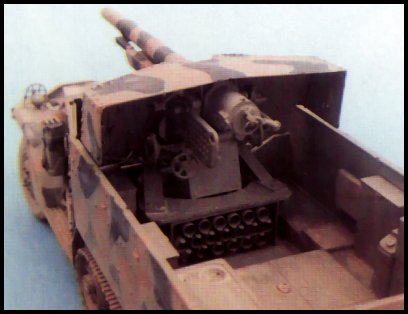 Bend the strips 17 round a paintbrush handle to make semi-circles and fix
the grilles 16 inside them - not on the front edge but half the way back. Bend the
bases of the 18s to about 45 degrees and fix one to each side of both guards, then fix
them as shown in my photos, slanting back.
Bend the strips 17 round a paintbrush handle to make semi-circles and fix
the grilles 16 inside them - not on the front edge but half the way back. Bend the
bases of the 18s to about 45 degrees and fix one to each side of both guards, then fix
them as shown in my photos, slanting back.
The only real disappointment of this conversion is that Kendall don't supply the actual
headlamps, so you'll have to either fit the inaccurate Tamiya ones as I did or model your
GMC with its headlamps removed - quite legitimate, they were often removed before going
into action because the gun blast shattered their glass. 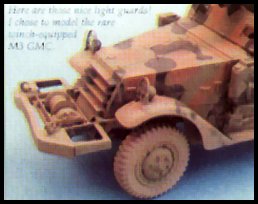 The real M3 GMC had headlamps of the pattern shown
on the box top photograph, so if you've anything like these in your spares box, fit them.
The real M3 GMC had headlamps of the pattern shown
on the box top photograph, so if you've anything like these in your spares box, fit them.
I painted my GMC in the US Marine three-colour scheme of faded olive drab, earth red
and black shown for a winch-equipped vehicle in one of the plates in Steve Zaloga's US
Tank Destroyers inCombat (Concord Armor at War series, 1996, ISBN 962 361 609 0).
Humbrol 155 and 186 provide the faded olive and earth red, with of course 33 for the
black, and the black-on-white unit markings on the gunshield have to be painted by hand.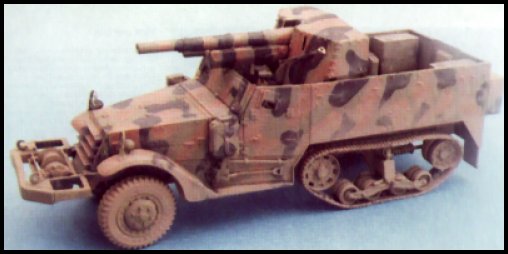
The Zaloga book includes some very useful photos and plates of M3 GMCs, and another good reference is M3 Half-Track In Action by Jin Mesko (Squadron/Signal Publications, 1996, ISBN 089747 363 9). This includes a clear photograph of the gun and mount which is very useful.
FINAL VERDICT
Kendall does deserve criticism for the missing headlamps, because you're entitled to
assume that what's shown on the box top is what's in the kit, but otherwise this is a
super kit which I recommend to anyone who feels capable of tackling the cutting needed on
the Tamiya floor.
Article published by Military Modelling Magazine Volume 28 Issue 1. Reproduced with permission from the Editor.
| Main | What's New | Articles | Reviews | Gallery | Think Tank | Contests |